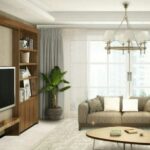Interior design is a complicated profession. It is sometimes referred to as interior architecture and often confused with interior decorating. It involves the design, organization and planning of an interior structure rather than just refinishing and furnishing existing interior spaces. It involves managing a business, hopefully meeting the desires of the client and delivering to them an interior environment that is both functional and aesthetically pleasing. There is a lot more to interior design than first meets the eye.
The further you go back in history, it can be seen how interior design has blended with artistic societies such as during the Italian Renaissance. It has been shaped by numerous styles, movements, social developments and technological revolutions. It has crossed emotional boundaries, traveled across continents and has publicly revealed much of the lifestyles of societies and their artistic cultures in any marked period in time.
There are different types of interior design. Residential interior design involves dealing with home owners normally on an available budget. Some interior designers specialize in working on bathrooms, kitchens, living areas or even bedrooms. Others work in the larger and lucrative commercial market. In this marketplace, interior designers are spoiled for choice and may select the retail industry, the hospitality business, the commercial building sector or specialize in related business as diverse as creating exhibits for art galleries and trade shows.
Interior Design is an exciting and rapidly growing field and it seems that interest in this particular career is increasing in popularity. Interior designers are licensed design professionals qualified by education, work experience and time. In the 1960s and 70s independent organizations were established to assess qualifications for these design professionals and their programs. There are now many dedicated individuals in organizations such as CIDA and NCIDQ who presently work diligently to increase public awareness of spacial design while developing the profession to where it is today.
There are ID courses in universities, colleges and even online and an accreditation process that certifies a program will teach the principles necessary to ensure that the students acquire the knowledge, skills and experience to be successful in their future careers. All of this is seen as beneficial to the consumer who can be virtually assured of being led through the design process by someone who is not only creative and educated but also competently trained.
Examine the basic family home. Basically it is a cluster of interconnected rooms each with a primary function such as eating, entertaining, sleeping, washing and possibly even working. The conscious aim of this form of spacial design is to balance the owner’s needs with the spaces available. It is rarely straightforward. There are so many external forces that influence the decision making process. The key to this art form is knowing how to make sense out of the relationship between the owner, the home, the family and their lifestyle.
Interior design is a process. This practice often involves the manipulation of texture, proportion and the efficient usage of light in order to achieve symmetry, harmony and a proper equilibrium in overall human life. The fundamental principles of good design are natural and to a large extent innate. When examining the universal properties of light, space, color and materials, the professional looks at the interaction of the natural laws that govern them.
The particular design of a room works not only on the often ignored senses of smell and hearing but also on the emotions. Color schemes are selected to reflect the mood of a room. Understanding how each aspect of a design contributes to an overall look and feel of a room or space constantly takes precise skills and both architects and designers manipulate these to great effect.
Interior Design is an expressive form of art. However there is a lot more to this profession than making a household look nice. It is about providing a simple answer to a simple problem in three dimensions by maximizing the good points and concealing the imperfections. It is all about purposely creating a harmonious environment that has the amazing ability to make positive changes in people’s lives. There is a lot more to interior design than first meets the eye.






